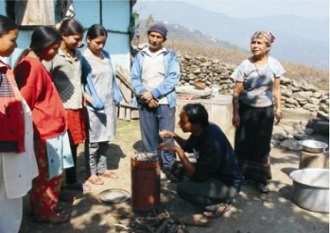War against global warming in rural kitchens of Sri Lanka
The demand for efficient stoves increased with many housewives falling victims to indoor air pollution.
Following this demand especially for large stoves, stoves were constructed without any assistance in areas where Kithul treacle is produced.
The demand for ‘Anag’-an efficient stove recommended and promoted by the Integrated Development Association (IDEA) is very popular and 20,000 stoves are produced monthly.
IDEA’S Executive Director R.M. Amarasekara told The Island Financial Review yesterday that that both dealers and consumers get the best out of the product.
“To date nearly two million stoves had been sold, they of three levels large, medium and small scale. I was behind this project since 1982 and to date we have trained about 300 persons,” he said.
He believes the demand will continue as people now use firewood for cooking, due to the price hike in LPG.
The sustainability of the kitchen improvement programme following the rehabilitation of Tsunami affected areas by the trained NGOs who have constructed many kitchens according to what they learned at the training.
In Sri Lanka, 55 per cent of the total energy consumed is derived from a variety of biomass resources of which 80 per cent is used for domestic cooking and 20 per cent in the industrial sector.
Nearly 90 per cent of rural households use biomass for cooking. Although biomass is a renewable, affordable and widely used source of energy, toxic gasses such as Carbon Dioxide, Carbon Monoxide, Methane, Oxides of Sulphur and Oxides of Nitrogen are released to the atmosphere while burning contributing to the Green House Effect-GHG- and the depletion of the Ozone layer causing global warming and climatic changes.
Amarasekara says most of the households and small industries cannot afford to use any other source of energy other than firewood which has become essential, especially for the rural poor.
He believes in this situation the most appropriate action is to introduce technologies to reduce the emission of these GHGs while used for domestic cooking and also small industries such as rice par-boiling, curd making, sweet making, etc.
Housewives using firewood for cooking are exposed to toxic emissions and are at the risk of suffering from ailments caused by wood smoke such as cataract, asthma, and other respiratory ailments, said Programme Director S. D. Abaywardana.
Improved Cooking Stoves (ICS) have been identified as one of the potential interventions to reduce the emission of greenhouse gasses and therefore it is considered as a CDM (Clean Development Mechanism) project.
A report by Dr. W.S. Hulscher titled `Stoves in the Carbon Market’ conclude: ‘A wood fuel stove project could well be put on the international carbon market at a competitive cost to reduce greenhouse gas emission. A report titled ‘Initial Evaluation of CDM Projects in Developing Countries’ by Dr. K.G. Bregg University of Surrey, commenting on the Sri Lankan ‘Anagi’ Improved Stove gives details of emission reduction ranging from 111 to 266 kg CO2/Capita/Year.
The main issues of the stove programme is, the production of low quality ‘Anagi’ imitations by untrained potters, and lack of trained personnel at rural level to design and construct stove to suit local requirements for household cooking and domestic industries.
Abayawardana says they have observed that a well managed kitchen with an improved stove and a chimney would reduce the emissions considerably and also reduce the indoor air pollution. Therefore an improved kitchen would lower the GHG emissions and also relieve housewives from suffering due to toxic emissions which causes many ailments.
Indoor air pollution equipment were used to measure the emission CO and particulate matter in Kirinda, Pallebedda, Kandy and Deraniyagala areas with the respective NGOs participation. Positive results were obtained as to the reduction of emissions after the improvements made to kitchens and a report to that effect was prepared and submitted to GEF.
Source – The Island, June 27, 2010



